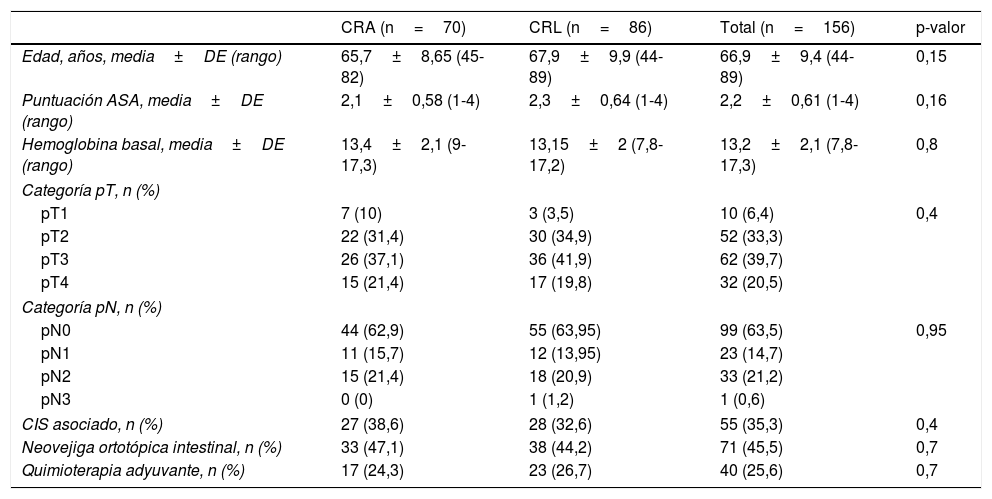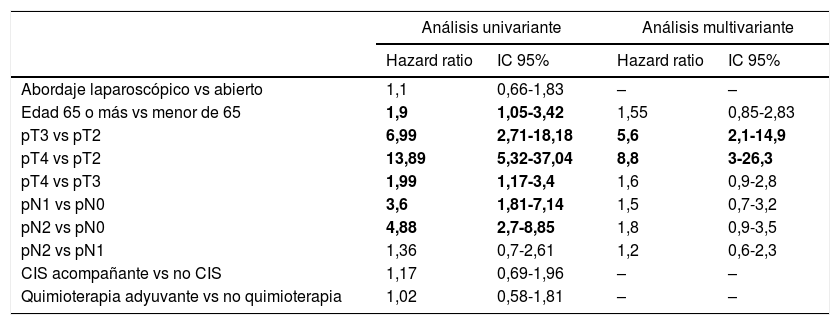La cistectomía radical laparoscópica con linfadenectomía y derivación urinaria es una cirugía de empleo creciente. Se necesitan estudios que avalen la efectividad oncológica y la seguridad de este abordaje mínimamente invasivo.
Pacientes y métodosEstudio prospectivo comparativo no aleatorizado entre cistectomía radical abierta (CRA) y laparoscópica (CRL) llevado a cabo en un hospital universitario. El objetivo principal fue comparar la supervivencia cáncer-específica, y el objetivo secundario comparar resultados operatorios y complicaciones según la escala Clavien-Dindo.
ResultadosCiento cincuenta y seis pacientes con cáncer vesical invasivo de alto grado fueron tratados mediante CRA (n=70) o CRL (n=86). El seguimiento medio fue 33,5±23,8 (rango 12-96) meses. La edad media fue 66,9+9,4 años y la proporción hombre/mujer 19:1. Ambos grupos fueron equivalentes en edad, estadio, ganglios positivos, carcinoma in situ, uropatía obstructiva preoperatoria, quimioterapia adyuvante y tipo de derivación urinaria. No hubo diferencias entre grupos en supervivencia cáncer-específica (log-rank; p=0,71). El estadio histopatológico fue la única variable independiente predictiva de pronóstico. La estancia hospitalaria (p=0,01) y la tasa de transfusión operatoria (p=0,002) fueron menores para CRL. La duración de la cirugía fue mayor para CRL (p<0,001). No hubo diferencias en la tasa de complicaciones totales (p=0,62) ni complicaciones mayores (p=0,69). El riesgo de evisceración (p=0,02), infección de herida quirúrgica (p=0,005) y neumonía (p=0,017) fue mayor en CRA. El riesgo de lesión rectal (p=0,017) y fístula uretrorrectal (p=0,065) fue mayor en CRL.
ConclusiónLa CRL es un tratamiento equivalente a la CRA en términos de eficacia oncológica, y ventajoso respecto a tasa de transfusión y estancia hospitalaria, pero no respecto a la ocupación de quirófano o a la seguridad global. Se necesitan estudios que definan mejor el perfil de seguridad específico de cada abordaje.
Laparoscopic radical cystectomy with lymphadenectomy and urinary diversion is an increasingly widespread operation. Studies are needed to support the oncological effectiveness and safety of this minimally invasive approach.
Patients and methodsA nonrandomised, comparative prospective study between open radical cystectomy (ORC) and laparoscopic radical cystectomy (LRC) was conducted in a university hospital. The main objective was to compare cancer-specific survival. The secondary objective was to compare the surgical results and complications according to the Clavien-Dindo scale.
ResultsWe treated 156 patients with high-grade invasive bladder cancer with either ORC (n=70) or LRC (n=86). The mean follow-up was 33.5±23.8 (range 12-96) months. The mean age was 66.9+9.4 years, and the male to female ratio was 19:1. Both groups were equivalent in age, stage, positive lymph nodes, in situ carcinoma, preoperative obstructive uropathy, adjuvant chemotherapy and type of urinary diversion. There were no differences between the groups in terms of cancer-specific survival (log-rank; P=.71). The histopathology stage was the only independent variable that predicted the prognosis. The hospital stay (P=.01) and operative transfusion rates (P=.002) were less for LRC. The duration of the surgery was greater for LRC (P<.001). There were no differences in the total complications rate (p=.62) or major complications (P=.69). The risk of evisceration (P=.02), surgical wound infection (P=.005) and pneumonia (P=.017) was greater for ORC. The risk of rectal lesion (P=.017) and urethrorectal fistulae (P=.065) was greater for LRC.
ConclusionLRC is an equivalent treatment to ORC in terms of oncological efficacy and is advantageous in terms of transfusion rates and hospital stays but not in terms of operating room time and overall safety. Studies are needed to better define the specific safety profile for each approach.
Artículo
Comprando el artículo el PDF del mismo podrá ser descargado
Precio 19,34 €
Comprar ahora
















